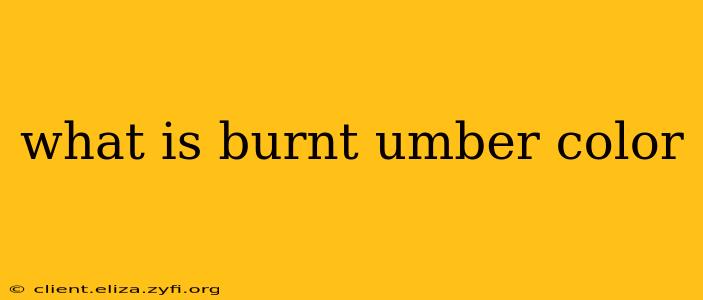Burnt umber is a rich, dark brown color with reddish-orange undertones. Its deep, earthy hue makes it a popular choice in art, design, and even home décor. But what exactly makes it unique, and how is it used? Let's delve into the fascinating world of burnt umber.
What Makes Burnt Umber Unique?
Unlike many other browns, burnt umber's distinctive character comes from its complex composition. It's a naturally occurring pigment derived from an iron-rich earth, typically containing varying amounts of iron oxides and manganese oxides. The "burnt" part of its name refers to the process of heating the raw umber, which alters its chemical structure, deepening its color and giving it its characteristic warm, reddish cast. This process significantly changes the hue, transforming the lighter, yellowish raw umber into the darker, richer burnt umber we know.
What are the Different Shades of Burnt Umber?
While the core characteristic remains a dark reddish-brown, subtle variations exist depending on the source of the raw umber and the heating process. Some burnt umbers lean more towards a reddish-brown, while others may have more of a brownish-red or even slightly purplish undertones. The level of transparency can also vary slightly, depending on the specific pigment and its formulation in paints or other mediums.
How is Burnt Umber Used?
Burnt umber's versatility is a key factor in its enduring popularity.
In Art and Painting:
It's a beloved pigment among artists for its ability to create depth and richness in paintings. Its earthy tones are perfect for landscapes, still lifes, and portraits, providing a strong base for shadows and creating a sense of realism. Many artists use it to create underpaintings, laying a foundation for more vibrant colors to be layered on top.
In Design and Interior Decor:
Burnt umber's warm, inviting nature makes it a popular choice in interior design. From walls painted in subtle burnt umber hues to furniture accents, it adds a touch of sophistication and grounding warmth to a space. This color often pairs well with neutral colors like beige and cream, as well as more vibrant tones like ochre or mustard yellow.
Other Uses:
Beyond art and design, burnt umber finds its way into various applications, including cosmetics and even some food coloring (although this is less common). Its natural origin often makes it a preferred choice in certain applications where natural or earth-toned pigments are desired.
What is the Difference Between Raw Umber and Burnt Umber?
This is a frequently asked question. Raw umber is the unheated form of the pigment. It’s typically a lighter, yellowish-brown compared to the darker, reddish-brown of burnt umber. The heating process significantly alters the color and creates the distinctive hue of burnt umber.
How Can I Create Burnt Umber at Home?
While achieving the exact same color as professional-grade burnt umber pigment might be difficult, you can experiment with creating similar earthy brown tones by mixing pigments. A mix of dark brown, red ochre, and a touch of black could yield a relatively close approximation.
What Colors Mix Well with Burnt Umber?
Burnt umber's versatility extends to its color harmony. It complements a wide range of colors beautifully:
- Complementary Colors: Colors opposite it on the color wheel, such as various shades of blue-green, create striking contrasts.
- Analogous Colors: Colors next to it on the color wheel, like various shades of red and brown, create harmonious blends.
- Neutral Colors: Cream, beige, gray, and off-white are excellent neutral partners that balance the richness of burnt umber.
By understanding its unique properties and versatility, you can appreciate the enduring appeal of burnt umber – a color as rich and complex as its history.
